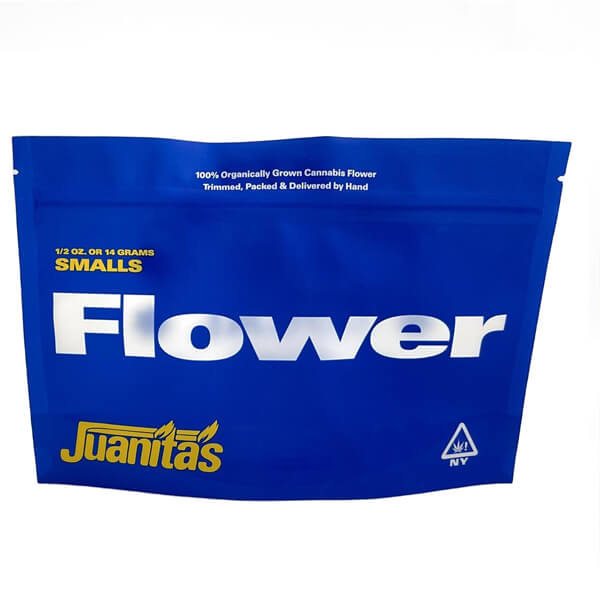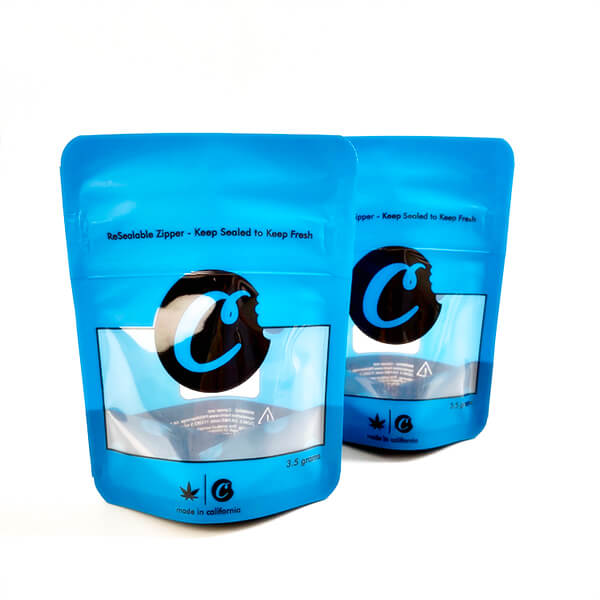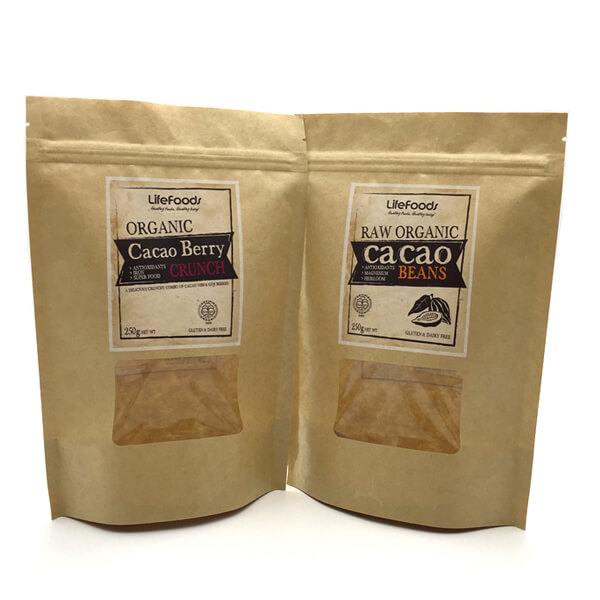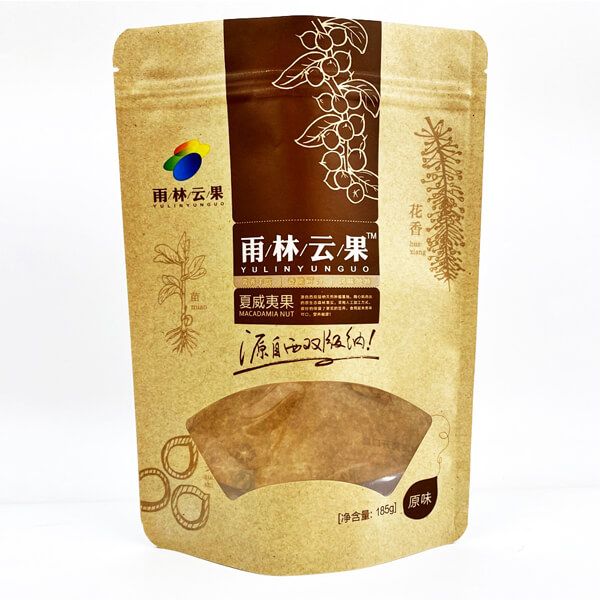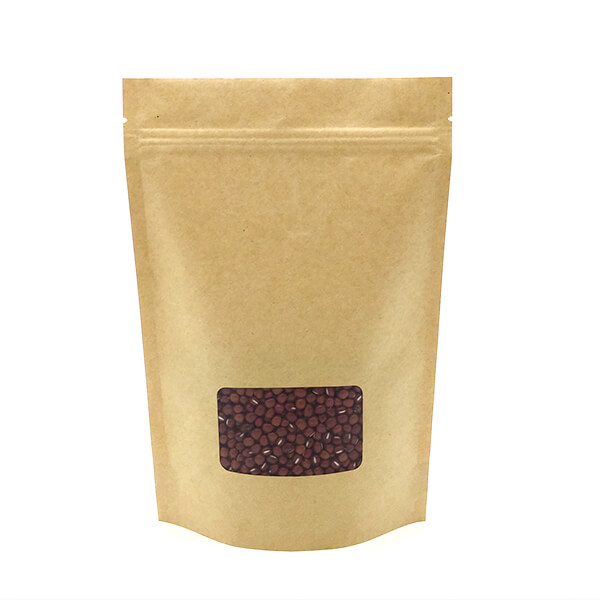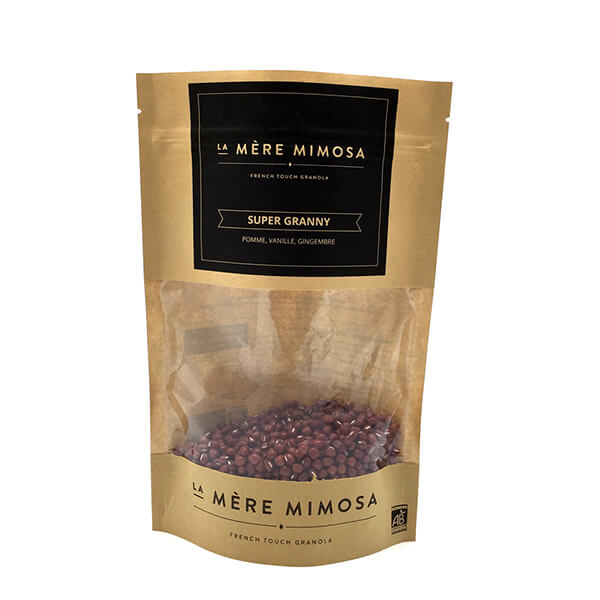Home » Bags & Pouches » Window Pouches » Window Pouches For Coffee
Window Pouches For Coffee
Window pouches for coffee packaging stand up on their own and feature a window to allow your customer to peek inside the bag and view the product. The bag has medium storage properties and can adequately protect the contents from external influences.
Please note that we have a MOQ for our pouch. For pouches in stock, the MOQ is 500 pcs. For customized pouches, please see the MOQ as followed:
1, Digital Printing — 500 pcs
2, Gravure Printing — 5,000pcs
Rinpac assists you throughout your project: bag shape, material, thickness, capacity and printing options. Please contact us or mark your requirements on the inquiry quotation.
Order single or thousands of items at a time. Our warehouse and flexible shipping options are available for last-minute, deadline critical orders.
- Free Sample
*Customization is always available, please mark down your need in cart or just contact us.
Specification
| MOQ | 500 PCS |
| Size | Per customer’s request |
| Material | BOPP/PET/NY+AL/PETAL/Kraft Paper/+LLDPE/CPP |
| Thickness | Per customer’s request |
| Custom Order | Accept |
| OEM | Yes |
| Sealing & Handle | Heat seal,zipper,hang hole |
Video
Request A Quote
Need something helped in a short time? We’ve got a plan for you.
Introduction to Window Pouches
Window pouches represent a versatile and innovative packaging solution that has gained significant traction across various industries. Characterized by a transparent window panel that offers a glimpse of the packaged product, window pouches combine functionality with visual appeal to capture consumer attention and drive sales.
In this introduction, we will delve into the definition, features, and applications of window pouches, highlighting their importance in modern packaging strategies. Whether used for food products, snacks, pet food, or personal care items, window pouches offer distinct advantages in terms of product visibility, branding opportunities, and consumer engagement.
Join us as we explore the world of window pouches and uncover their role in shaping the future of packaging solutions.
Advantages of Using Window Pouches for Coffee
Window pouches offer numerous benefits for packaging coffee, catering to both practical and marketing needs. Here are some advantages:
Increased Visibility: One of the primary advantages of using window pouches for coffee is the enhanced visibility they provide. The transparent window allows consumers to see the coffee beans or ground coffee inside, giving them a preview of the product’s quality, color, and texture. This increased visibility captures attention on store shelves, enticing customers and encouraging them to make a purchase based on the product’s appearance.
Freshness Preservation: Window pouches are designed to preserve the freshness of coffee by providing a barrier against external elements such as moisture, oxygen, and light. The airtight seal of the pouches helps to maintain the coffee’s aroma, flavor, and quality over time, ensuring that each cup of coffee delivers a rich and satisfying experience. With their ability to protect coffee from environmental factors, window pouches contribute to extending the shelf life of the product and enhancing customer satisfaction.
Customization Options: Window pouches offer versatile customization options that allow coffee brands to showcase their unique identity and differentiate themselves in the market. From customizable shapes and sizes to vibrant graphics and branding elements, window pouches provide a canvas for creative expression. Brands can leverage custom printing techniques, such as digital printing or foil stamping, to display their logos, slogans, and product information prominently on the pouches, effectively communicating their brand story and values to consumers.
By leveraging the increased visibility, freshness preservation, and customization options offered by window pouches, coffee brands can effectively showcase their products, maintain product quality, and establish a strong brand presence in the competitive coffee market.
Materials Used in Window Pouches
Window pouches are constructed using a variety of materials, each offering unique properties and advantages for packaging applications. Here are some common materials used in the production of window pouches:
Plastic: Plastic films, such as polyethylene (PE), polypropylene (PP), and polyester (PET), are commonly used in the manufacturing of window pouches. These materials are known for their flexibility, durability, and excellent barrier properties, which help protect the contents of the pouches from moisture, oxygen, and external contaminants. Plastic window pouches are lightweight, cost-effective, and suitable for a wide range of products, making them a popular choice in the packaging industry.
Paper: Paper-based materials, including kraft paper, coated paper, and cardboard, are also used in the production of window pouches. Paper window pouches offer a natural and eco-friendly packaging solution, appealing to environmentally conscious consumers. They are recyclable, biodegradable, and often made from renewable resources, making them a sustainable choice for packaging applications. Paper window pouches provide good printability, allowing brands to showcase their logos, designs, and product information effectively.
Foil: Foil materials, such as aluminum foil or metallized films, are utilized in window pouches to provide superior barrier properties and protection against light, moisture, and oxygen. Foil window pouches offer excellent product protection, particularly for sensitive or perishable goods that require extended shelf life. The reflective surface of foil materials helps maintain product freshness by minimizing exposure to external elements and preserving the aroma and flavor of the packaged contents.
By leveraging a combination of plastic, paper, and foil materials, manufacturers can tailor window pouches to meet specific packaging requirements, ensuring product integrity, visual appeal, and sustainability.
Design Considerations for Window Pouches
When designing window pouches, several factors must be taken into account to ensure functionality, visual appeal, and brand representation. Here are some key design considerations:
Size and Shape: The size and shape of window pouches play a crucial role in accommodating the packaged product and optimizing shelf space utilization. Pouch dimensions should be carefully chosen to fit the product comfortably while providing sufficient room for sealing and handling. Additionally, unique shapes or custom die-cut windows can help differentiate the pouches and attract consumer attention on store shelves.
Window Placement: The placement of the window on the pouch is essential for showcasing the product effectively. The window should be strategically positioned to offer maximum visibility of the contents while maintaining structural integrity and sealing strength. Considerations such as product positioning, branding elements, and regulatory requirements should be taken into account when determining the optimal window placement.
Branding and Graphics: Window pouches present an opportunity for brands to reinforce their identity and communicate their message through branding and graphics. Eye-catching logos, vibrant colors, and compelling imagery can enhance brand recognition and consumer engagement. Brands should carefully consider the placement and design of branding elements to ensure they complement the overall aesthetics of the pouches and resonate with the target audience.
By carefully considering size and shape, window placement, and branding and graphics, designers can create window pouches that effectively showcase the product, capture consumer attention, and reinforce brand identity.
Environmental Impact of Window Pouches
As consumer awareness of environmental issues continues to grow, the sustainability of packaging materials has become a significant concern for brands and consumers alike. When it comes to window pouches, there are several considerations regarding their environmental impact and potential solutions to mitigate their footprint. Here’s a closer look:
Recycling Options: Many window pouches are made from materials that are recyclable, such as certain types of plastics and papers. However, the recyclability of window pouches depends on the specific materials used and local recycling capabilities. To ensure proper recycling, brands should provide clear instructions on how to dispose of their pouches responsibly. Additionally, efforts to improve recycling infrastructure and increase consumer education can help maximize the recycling rate of window pouches.
Biodegradable Alternatives: In response to growing environmental concerns, manufacturers are increasingly exploring biodegradable alternatives for window pouches. These materials are designed to break down naturally over time, reducing their environmental impact and minimizing waste. Biodegradable window pouches are typically made from renewable resources such as plant-based polymers or compostable materials. While biodegradable options offer promise for reducing the environmental footprint of window pouches, it’s essential to ensure that they meet certification standards and can be effectively composted in industrial facilities.
By prioritizing recycling options and exploring biodegradable alternatives, brands can minimize the environmental impact of window pouches and contribute to a more sustainable packaging industry.
Cost Efficiency of Window Pouches
Cost efficiency is a critical consideration for businesses when choosing packaging solutions, including window pouches. Here’s a closer look at factors influencing the cost efficiency of window pouches:
Material Costs: The choice of materials used in manufacturing window pouches significantly impacts their cost efficiency. Different materials have varying price points, with factors such as recyclability, durability, and barrier properties affecting costs. While certain materials may offer superior performance, they may also come at a higher price. Balancing material costs with desired packaging attributes is essential for maximizing cost efficiency.
Production Costs: The manufacturing process for window pouches involves various steps, including printing, lamination, and sealing. Production costs can vary based on factors such as production volume, complexity of design, and equipment requirements. High-volume production runs often result in lower unit costs due to economies of scale. However, factors such as customization and special features may increase production costs. Optimizing production processes and streamlining operations can help enhance cost efficiency.
Packaging Design: The design complexity and customization options chosen for window pouches can influence their cost efficiency. Intricate designs, special finishes, and custom features may incur additional expenses during production. Simplifying designs, standardizing specifications, and utilizing pre-designed templates can help reduce design costs without compromising quality or branding effectiveness.
Logistics and Distribution: Transportation and distribution costs also play a significant role in the overall cost efficiency of window pouches. Factors such as packaging size, weight, and shipping distances impact logistics expenses. Optimizing packaging dimensions to maximize shipping efficiency and reducing unnecessary packaging materials can help minimize transportation costs.
By carefully evaluating material choices, production processes, packaging design, and logistics considerations, businesses can achieve cost-efficient window pouch solutions that meet their budgetary requirements without sacrificing quality or performance.
Types of Window Pouches
Window pouches come in various configurations to suit different packaging needs and product requirements. Here are some common types of window pouches:
Stand-up Pouches: Stand-up pouches are versatile packaging solutions characterized by their ability to stand upright on store shelves, offering excellent visibility and space-saving benefits. These pouches feature a bottom gusset that expands when filled, allowing them to stand securely without the need for additional support. Stand-up pouches with a window panel provide consumers with a clear view of the packaged product, making them ideal for showcasing food items, snacks, pet treats, and more.
Flat Bottom Pouches: Flat bottom pouches, also known as box pouches or block bottom pouches, feature a flat base that provides stability and allows them to stand upright. These pouches offer ample space for branding and product information, making them suitable for a wide range of applications, including coffee, tea, nuts, and dried fruits. The addition of a window panel enhances product visibility and shelf appeal, attracting consumers’ attention while maintaining product freshness.
Side Gusset Pouches: Side gusset pouches are characterized by their expandable side gussets, which allow the pouches to accommodate larger volumes of products while maintaining a sleek and compact appearance. These pouches are commonly used for packaging coffee beans, loose-leaf tea, snacks, and confectionery items. The incorporation of a window panel on the front or side of the pouch enhances product visibility and allows consumers to see the contents inside, making them an attractive option for retail packaging.
Each type of window pouch offers unique advantages in terms of presentation, functionality, and shelf presence, allowing brands to effectively showcase their products and engage consumers on store shelves.
Usage and Storage Tips for Window Pouches
To ensure optimal performance and preserve the quality of products packaged in window pouches, it’s essential to follow proper usage and storage practices. Here are some tips to consider:
Fill Pouches Correctly: When filling window pouches, ensure that the contents are evenly distributed and do not exceed the recommended fill volume. Overfilling pouches can compromise sealing integrity and lead to bulging or bursting, affecting both the appearance and functionality of the packaging.
Seal Pouches Properly: Use appropriate sealing equipment and techniques to ensure a tight and secure seal along the edges of the pouch. Proper sealing prevents leakage, maintains product freshness, and extends shelf life. Verify that the sealing process is uniform and consistent to avoid weak spots or gaps in the seal.
Handle Pouches Carefully: Handle window pouches with care to avoid punctures, tears, or damage to the packaging. Avoid rough handling during transportation, storage, and display to preserve the integrity of the pouches and prevent product spoilage or contamination.
Store Pouches in Suitable Conditions: Store window pouches in a clean, dry, and temperature-controlled environment to protect them from moisture, humidity, and direct sunlight. Avoid exposure to extreme temperatures or fluctuations, as they can affect the stability and performance of the packaging materials.
Rotate Stock Regularly: Implement a first-in-first-out (FIFO) inventory management system to ensure that older stock is used before newer batches. Rotating stock helps prevent product expiration and ensures that customers receive fresh and high-quality goods.
Monitor Shelf Life: Keep track of the shelf life of products packaged in window pouches and adhere to recommended storage conditions to maintain product quality and safety. Regularly inspect pouches for signs of damage, deterioration, or tampering, and promptly remove any compromised packages from circulation.
By following these usage and storage tips, businesses can maximize the effectiveness and longevity of window pouches, delivering superior products to consumers while minimizing waste and ensuring brand integrity.
Future Trends in Window Pouch Packaging
As the packaging industry continues to evolve in response to changing consumer preferences, market dynamics, and technological advancements, several future trends are expected to shape the landscape of window pouch packaging. Here are some anticipated trends:
Sustainable Materials: With growing concerns about environmental sustainability, there is a rising demand for window pouches made from eco-friendly and biodegradable materials. Manufacturers are exploring innovative materials and production processes to reduce the environmental footprint of packaging while maintaining performance and functionality.
Smart Packaging Solutions: The integration of smart technologies into window pouch packaging is expected to revolutionize product traceability, authentication, and interactive consumer experiences. Smart packaging features such as QR codes, NFC tags, and RFID sensors enable brands to communicate product information, enhance engagement, and track supply chain logistics in real-time.
Customization and Personalization: Consumers increasingly seek personalized and customized products that reflect their individual preferences and lifestyles. Window pouch packaging offers opportunities for brands to incorporate personalized elements such as custom graphics, messaging, and interactive features, creating unique and memorable experiences for consumers.
Enhanced Barrier Properties: Advances in material science and packaging technology are driving improvements in barrier properties, extending the shelf life and freshness of products packaged in window pouches. Innovative barrier films and coatings help protect against oxygen, moisture, light, and other environmental factors, preserving product quality and integrity for longer periods.
E-commerce Packaging Solutions: The rapid growth of e-commerce has led to the emergence of specialized packaging solutions tailored to the unique requirements of online retailing. Window pouches designed for e-commerce applications prioritize durability, tamper resistance, and efficient shipping, ensuring products arrive safely and securely to consumers’ doorsteps.
Minimalist Design Aesthetics: Simplicity and minimalism are becoming increasingly prevalent in packaging design, driven by consumer preferences for clean, modern aesthetics and clutter-free branding. Window pouches with minimalist designs and unobtrusive branding elements convey a sense of sophistication and elegance, resonating with discerning consumers seeking simplicity in their purchasing decisions.
By embracing these future trends, businesses can stay ahead of the curve, differentiate their products, and meet the evolving needs and expectations of consumers in an ever-changing marketplace.
Conclusion
In conclusion, window pouch packaging offers a versatile and visually appealing solution for a wide range of products across various industries. With its combination of transparency, functionality, and branding opportunities, window pouches have become increasingly popular among consumers and businesses alike.
Throughout this comprehensive guide, we’ve explored the different types of window pouches, their advantages, materials used, design considerations, and future trends. From stand-up pouches to flat bottom pouches, window packaging provides brands with the ability to showcase their products effectively while ensuring freshness, convenience, and sustainability.
As the packaging industry continues to innovate and adapt to changing consumer preferences and market dynamics, window pouches are poised to play a significant role in shaping the future of packaging solutions. With advancements in sustainable materials, smart packaging technologies, and personalized experiences, window pouch packaging will continue to evolve to meet the evolving needs of consumers and businesses.
By understanding the benefits, considerations, and emerging trends in window pouch packaging, brands can leverage this versatile packaging solution to enhance their product offerings, differentiate themselves in the market, and drive success in an increasingly competitive landscape.

